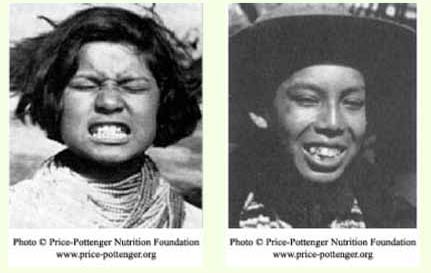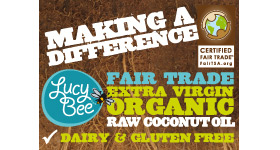|
|
|
Nutrition pioneer and dentist, Dr Weston Price believed that humans achieve perfect physical form and perfect health generation after generation only when they consume nutrient-dense whole foods and the vital fat-soluble activators found exclusively in animal fats. If we were to eat this way, the supporters of his theories believe that allergies, intolerances and many of today's chronic conditions would disappear.
I first came across the Weston A. Price Foundation (WAPF) on the net some five years ago. I devoured the wealth of fascinating ‘politically incorrect’ dietary information it contained, and became a convert straight away. As a health writer, specialising in candida and chronic fatigue I was all too familiar with the need to cut out certain foods such as gluten and dairy. As a former trustee of Action for ME I had got to know many sick people over the years who were down to their last foods, or who opted for densensitisation vaccines in order to tolerate more foods, crippling themselves financially as a result. Could WAPF provide alternative answers to these problems? For example, WAPF provided cogent, well researched and convincing evidence which explained why drinking raw milk was usually tolerated by those with lactose intolerance, and why pasteurised milk is far from being the same product. The Weston A. Price Foundation is a nonprofit US charity founded in 1999 to disseminate the research of nutrition pioneer and dentist, Dr. Weston Price. Dr. Price's research demonstrated that humans achieve perfect physical form and perfect health generation after generation only when they consume nutrient-dense whole foods and the vital fat-soluble activators found exclusively in animal fats. (1) Apart from what the Foundation says, what does it do? One of its most moving campaigns is its lawsuit against the state of Illinois, which for seven years has fed its prisoners soy protein instead of meat. The governor's justification for replacing meat and cheese with soy protein was financial. However, it may be relevant that the main supplier of soy products to the Illinois prisons made substantial contributions to the Governor's election campaign. WAPF has documented the health problems that the prisoners are now facing, after the prisoners approached them for help. Traditional Cultures Dr Price found that all traditional cultures consume some sort of animal food, including insects. Importantly, the whole animal is consumed – muscle meat, organs, bones and fat, with the organ meats and fats preferred. Thus, American Indians, when hunting, would throw the muscle meat to the dogs, reserving the organ meat, the most nutritious, for themselves. Primitive and traditional diets have a high content of food enzymes and beneficial bacteria from lacto-fermented vegetables, fruits, beverages, dairy products, meats and condiments. Seeds, grains and nuts are soaked, sprouted, fermented or naturally leavened to neutralize naturally occurring anti-nutrients such as enzyme inhibitors, tannins and phytic acid. Total fat content of traditional diets varies from 30% to 80% of calories but only about 4% of calories come from polyunsaturated oils naturally occurring in grains, legumes, nuts, fish, animal fats and vegetables. The balance of fat calories is in the form of saturated and monounsaturated fatty acids. Traditional diets contain nearly equal amounts of omega-6 and omega-3 essential fatty acids. All traditional diets contain some salt. All traditional cultures make use of animal bones, usually in the form of gelatin-rich bone broths. Looking at the photographs Dr Price had taken of nonindustrialised peoples, before the introduction of a Western diet, is instructive. Wide jaws, and uncrowded perfect teeth give plenty of room for neural pathways to the brain. Once a western diet was introduced facial structures became narrower and teeth more crowded, with inevitable consequences to health.
The "primitive" Seminole (left) has a wide, handsome face with plenty of room for the dental arches. The "modernized" Seminole girl (right), born to parents who had abandoned their traditional diets, has a narrowed face, crowded teeth
The photo in the upper right is of healthy Aborigine woman on the traditional diet, compared to her compatriots who lived in the town and were eating our foods. Dr. Price called these foods "the displacing foods of modern commerce." They were not only empty foods but they were pushing out – displacing – the nutrient-dense calories of the traditional diet. Below is what our modern children look like. Many need braces to straighten their teeth. They are plagued with allergies, asthma, learning disabilities, and even diseases that were formerlly associated with adults, like cancer and arthritis.
As someone immune to the need to follow ‘rules’ I had never been taken in by the ‘low fat is healthy’ government dictat. I used my eyes, when in France, and their high protein, high animal fat diet, with cheeses, and salad dressings, did not seem to result in childhood obesity, or overweight adults. In parts of the world where fruit or vegetables are limited, as in Alaska, how to explain that diets as much as 80% fat did not result in heart attacks, or shortened lives? So Weston Price’s ideas were not hard to accept. Other people do need convincing, of course, especially vegetarians. Its usually beliefs about protecting animals which dictate vegetarian and vegan food choices. But this projection onto the animal world misses the point of our interdependence. Furthermore isolated nonindustrialised societies don’t have choice. On the other hand we can define ourselves by the fact that we do have choice to eat ‘new’ industrialised foods, instead of what our grandparents ate. Click here for WAPF coments on the USDA Dietary Guidelines. So it’s not a surprise that last November saw me checking in to the WAPF national convention in Philadelphia, along with 1,500 others. Local groups are organised as chapters, and apart from ordinary members flying in for a feast of talks and networking, there were a large number of farmers, including many local Amish and Mennonite farmers. WAPF members in the US All these farmers farm sustainably, raising pasture fed cattle and/or raw milk, often struggling to survive against a state bureaucracy that favours chemicalised large scale food production. WAPF has set up a Farm-to-Consumer Legal Defence Fund to protect farmers from armed raids in some states. Advice to farmers is to install cameras at home to film gun toting officers who may turn up in the middle of the night. The forthcoming film Farmageddon, shown at the conference, tells the story of a mother whose son healed from allergies and asthma after consuming raw milk, and pastured farm foods. It showed how food co-ops and private clubs mushroomed to access these foods, and how state and local governments often responded in an aggressive way. One of the most useful panel discussions was on Effective Food Activism, on how to harness the power of social media to promote educational messages about wholesome traditional foods. A number of highly successful food bloggers talked about how to inspire others to cook traditional foods, and how to push further for change in the American diet. Check the Nourished Kitchen blog. Living with the Inupiat The most interesting delegate I met was one of the speakers, Anore Jones. She lived with the Inupiat in NW Alaska for 23 years, from the sixties to the eighties, raising a family and foraging for food with an Inupiat woman, whilst their husbands commercially fished. Her book on fish is free to download. (2) She described a feeling of increased energy and warmth when she ate frozen fish, straight from the ‘freezer’ (a hole in the ground) , and the central role in the diet of fat, from seals, and from fish. Seal liver and berry ice-cream was a particular favourite for dessert! For one whole year there was nothing to eat but caribou. Inupiat wisdom describes the relationship between hunter and hunted. The hunter in connecting energetically with the caribou has the feeling that they present themselves to be killed, in times of imminent starvation, as part of the cycle of life. No wonder gratitude is embedded in such cultures, and a deep connection with the animal world. At this point I hear the cries of protest. The romanticism of looking backwards at small scale traditional societies. How can we feed the billions now able to afford meat, and stay true to the collective food wisdom from the past? Aren’t the fish stocks running out? Some of the answers to these concerns were addressed by well known Virginia farmer Jo Salatin, who held the keynote spot before the banquet on Saturday night. Jo Salatin and Polyface Farm Salatin pointed to the fact that our culture generally embraces the wonder of animals’ ecological symbiosis, but does not understand the same principles when applied to domestic livestock. The combination of poor farming practices and the Bambiizing of America have colluded to make human carnivores politically incorrect. On the contrary, he believes that animals and humans can relate symbiotically to heal land, economies and people.
Amazing when you consider the numbers. Hotel chefs had to work alongside WAPF cooks to produce food thoroughly in tune with WAPF principles. The Saturday Banquet had raw milk flowing as freely as the wine. The mountains of butter were so far removed from individual pats as to be shocking to any English sense of portion control. Such excess, in a world of shortage, has to be put in the context of a celebration of good healthful food, against the forces outside which demonise and deny. And after all sharing a conference with donor farmer participants has to have advantages! Whatever your stance on animal products, soya beans and vegan diets, its not hard to support WAPF’s overriding principle which holds that modern technology should be harnessed as a servant to the wise and nurturing traditions of our ancestors rather than used as a force destructive to the environment and human health. The WAPF London Chapter is putting on a conference here in March for those of you curious to find out more. Or download a video presentation for free.
References 1.
Weston A. Price, MS., D.D.S., F.A.G.D. (1939) "Nutrition and Physical Degeneration : A Comparison of Primitive and Modern Diets and Their Effects"
2. Federal Subsistence programme. Click on Northwest Arctic and then on Iqaliuch Niginaqtuat, Fish That We Eat.
Gill Jacobs is a health writer, having written books on Chronic Fatigue Syndrome and Candidiasis. Alongside her passion for food as the base of health, balance and connection to others, she runs her own business in Low Level Laser Light, Light for Health. First published in 2011
Click here for more articles Click here for LINKS to manufacturers of nutrition and food supplements. |












